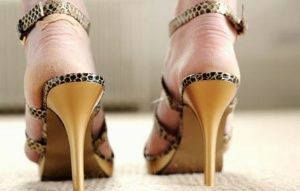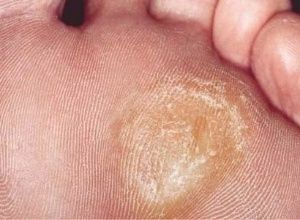 Natoptysh is a seal of the superficial epithelium of the skin on the soles, which develops due to prolonged and repeated mechanical irritation and pressure. From constant rubbing blood circulation is disrupted and the process of keratinization of the skin is intensified.
Natoptysh is a seal of the superficial epithelium of the skin on the soles, which develops due to prolonged and repeated mechanical irritation and pressure. From constant rubbing blood circulation is disrupted and the process of keratinization of the skin is intensified.
Tread on the legs are painful and burning when walking.
The most frequent place of their location is the base of the toes and the pads beneath them. It is well developed subcutaneous fatty tissue, so many do not immediately detect the onset of the formation of corns. Painful sensations can be absent until the pathological process grows in breadth and does not grow into the depths.
According to statistics, women suffer from nattoids ten times more often than men. These figures can easily be explained by the readiness of the beautiful half of humanity to sacrifice for the sake of beauty amenities, wear narrow, uncomfortable shoes and high-heeled shoes.
Reasons for
The main reason for the appearance of corns on the feet is the wrong choice of shoes.
Narrow, tight high-heeled shoes, with stiff insole and thin sole cause discomfort and increase load on the soles of the feet. After prolonged wearing of new shoes, the legs are in a state of stress: they are scuffed, reddened, bleeding abrasions, which prevent further wear of other shoes.Hemophilia, like these pathological formations, are formed on the feet, but for a longer time. This is due to the uneven load of the person's weight on different parts of the foot. Those that are most damaged are gradually subjected to keratinization. So the human body prevents the formation of injuries on the legs. In advanced cases, the napotypes become cracks that can not be cured.
Why on the feet do they appear on the ground? The reasons are many, but the most common are the following:
- Extra weight is the second most popular reason for the appearance of corns.
- Disturbed microcirculation in the legs.
- Contact with garbage in shoes.
- Inconvenient shoe and deformed insole.
- Disturbance of calcium metabolism.
- Increased sweating of feet.
- Changes in the shape of the foot - flat feet or bony growths on the joints - lead to an uneven distribution of pressure. In places of maximum pressure on the foot, there are burrs.
- Rheumatoid arthritis and certain diseases of the nervous system increase the risk of pathology.
- Ballerinas and runners are a decreed contingent, most often prone to the appearance of corns.
Symptoms of coriander
 The initial stage of the development of the disease manifests itself in the redness and swelling of the foot. In the photo, we see that the foot on the leg is a yellow patch of skin that does not have clear boundaries, with a smooth or rough surface and cracks of different depths. The nares are usually flat or slightly convex. The skin of the affected area is characterized by a decreased sensitivity. During walking it is possible to have painful sensations. The pain becomes quite strong with inflammation and infiltration of the focus, as well as when deep cracks appear on the foot.
The initial stage of the development of the disease manifests itself in the redness and swelling of the foot. In the photo, we see that the foot on the leg is a yellow patch of skin that does not have clear boundaries, with a smooth or rough surface and cracks of different depths. The nares are usually flat or slightly convex. The skin of the affected area is characterized by a decreased sensitivity. During walking it is possible to have painful sensations. The pain becomes quite strong with inflammation and infiltration of the focus, as well as when deep cracks appear on the foot.
Pain occurs when the thumb of the foot is enlarged and displaced relative to all other fingers. The load on the thumb thus increases, which causes intermittent, aching, or persistent pain. The result of the formation of the foot on the toes is soft tissue edema and skin hyperemia.
Honey combs are one of the most common foot diseases, outwardly resembling keratinized skin areas without a stem, causing pain when walking. In size, small and large formations are distinguished. The bony protuberances, sometimes located on the fifth toe, are sometimes called natypesises. If there are damaged corns, there is no bloody discharge.
Treads between the toes sometimes lead to the formation of cracks, which become inflamed and very painful.
This disease often acquires a chronic course and can cause flat feet.
Why are the feet sore?
Pain in the place of the attack on the body is a protective reaction of the body. The thickened layer of the skin should protect the deeper nerves and blood vessels from further damage. But if this does not happen, the pathological process grows inside, penetrating into soft tissues, exerting even more pressure on the nerves, the experienced blood vessels. This is how acute, unbearable pain develops.
Sealing can appear around a foreign body - drifts or splinters, warts. There is development of inflammation and there is soreness, which increases with walking.
Pain on the feet on feet with irregular gait. The reason for this is the features of the human skeleton. Correct this defect is not easy, and remove pathological education is even more difficult. The plane of the foot is compensated for and the surface gradually becomes level, which leads to an improvement in walking.
